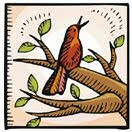Moss, fungi, lichens, and an alien invader
 Here's a look at some of the life that's thriving in the woods in mid-February, despite the long cold spell we've just had. The moss is lush and green, and the lichens are practically glowing. Beige fungi are digesting the dead branch.
Here's a look at some of the life that's thriving in the woods in mid-February, despite the long cold spell we've just had. The moss is lush and green, and the lichens are practically glowing. Beige fungi are digesting the dead branch.I see a few sprigs of honeysuckle -- the stems with green leaves at left. Honeysuckle vine, a non-native, invasive species, is rampant along the edges of these woods. Here in Kentucky, it's a nearly-evergreen plant. It can climb to great heights by twining and twisting around trunks and branches, and once it reaches sunlight, it forms its own canopy over the canopy of its host tree or shrub, depriving the host of sunshine and subjecting it to a great deal of stress from the weight of the overgrowth.
Lichens are interesting things. They're composite organisms -- that is, they're made of fungi growing together with something else (usually algae) in a symbiotic relationship. Many of the lichens even reproduce by making a diaspore that contains cells from both partners.
I've noticed that the lichens seem to do very well in winter in Kentucky. Lichens are so immune to damage from cold that they survived unprotected in space in an experiment conducted by astronauts -- thus a few months with temperatures below freezing are nothing to them. The leaves are off the trees, so they get plenty of sunshine and there's usually plenty of moisture too, since we get a lot of our annual rainfall during the winter months.
I don't know what sort of fungus that is, but it seems to be a benign part of the circle of life, just helping that tree branch decompose. However, some fungi can be a big problem to living trees. Heart-rotting fungi may not kill a tree immediately but will destroy its lumber value. Root-rotting fungi make the tree vulnerable to windfall. Then there's the various fungal diseases that can kill trees, such as oak wilt and dogwood anthracnose and many other molds, wilts, rusts, etc.
 I love to see green patches of moss in winter. The bit of bright color is a welcome accent to winter's muted palette of browns. Like the lichens, the moss thrives in the damp conditions and cool temperatures of winter and takes its dormant time during the hot, dry months of summer. That sounds good to me! I don't like hot weather either!
I love to see green patches of moss in winter. The bit of bright color is a welcome accent to winter's muted palette of browns. Like the lichens, the moss thrives in the damp conditions and cool temperatures of winter and takes its dormant time during the hot, dry months of summer. That sounds good to me! I don't like hot weather either!


 "The power to recognize trees at a glance without examining their leaves or flowers or fruit as they are seen, for example, from the car-window during a railroad journey, can only be acquired by studying them as they grow under all possible conditions over wide areas of territory. Such an attainment may not have much practical value, but once acquired it gives to the possessor a good deal of pleasure which is denied to less fortunate travelers."
"The power to recognize trees at a glance without examining their leaves or flowers or fruit as they are seen, for example, from the car-window during a railroad journey, can only be acquired by studying them as they grow under all possible conditions over wide areas of territory. Such an attainment may not have much practical value, but once acquired it gives to the possessor a good deal of pleasure which is denied to less fortunate travelers."
1 comments -- please add yours:
I know that I am going to find this blog intensively addictive. I love trees and all of the natural neighbors of trees, such as the humble but important lichens and mosses.
Post a Comment